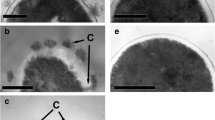Abstract
We have studied the induction of peroxisomes in the methylotrophic yeast Candida boidinii by d-alanine and oleic acid. The organism was able to utilize each of these compounds as the sole carbon source and grew with growth rates of μ=0.20 h-1 (on d-alanine) or μ=0.43 h-1 (on oleic acid). Growth was associated with the development of many peroxisomes in the cells. On d-alanine a cluster of tightly interwoven organelles was observed which made up 6.3% of the cytoplasmic volume and were characterized by the presence of d-amino acid oxidase and catalase. On oleic acid rounded to elongated peroxisomes were dominant which were scattered throughout the cytoplasm. These organelles contained increased levels of β-oxidation enzymes; their relative volume fraction amounted 12.8% of the cytoplasmic volume.
Similar content being viewed by others
References
Bradford MM (1976) A rapid and sensitive method for the quantitation of microgram quantities of protein utilizing the principle of protein dye binding. Anal Biochem 72:248–254
Dijken JP van, Veenhuis M, Vermeulen CA, Harder W (1975) Cytochemical localization of catalase activity in methanol grown Hansenula polymorpha. Arch Microbiol 105:216–267
Dijken JP van, Otto R, Harder W (1976) Growth of Hansenula polymorpha in a methanol-limited chemostat. Physiological responses due to the involvement of methanol oxidase as a key enzyme in methanol metabolism. Arch Microbiol 111: 137–144
Dixon G, Kornberg HL (1959) Assay methods for key enzymes of the glyoxylate cycle. Biochem J 72:3–9
Douma AC, Veenhuis M, de Koning W, Evers M, Harder W (1985) Dihydroxyacetone synthase is localized in the peroxisomal matrix of methanol grown Hansenula polymorpha. Arch Microbiol 143:237–243
Fukui S, Tanaka A (1979) Yeast peroxisomes. Trends Biochem Sci 4:246–249
Goodman JM, Scott CW, Donahue PN, Atherton JP (1984) Alcohol oxidase assembles post-translationally into the peroxisome of Candida boidinii. J Biol Chem 259:8485–8493
Goodman JM, Maher J, Silver PA, Pacifico A, Sanders S (1986) The membrane proteins of the methanol induced peroxisome of Candida boidinii. Biol Chem 261:3464–3468
Kionka Chr, Kunau WH (1985) Inducible β-oxidation pathway in Neurospora crassa. J Bacteriol 161:153
Kunau WH, Kionka Chr, Ledebur A, Mateblowski M, Moreno de la Garza M, Schultz-Borchard U, Thieringer R, Veenhuis M (1987) β-Oxidation systems in eukaryotic microorganisms. In: Fahimi HD, Sies H (eds) Peroxisomes in biology and medicine. Springer, Berlin Heidelberg New York, pp 128–140
Lück H (1963) Catalase. In: Bergmeyer HU (eds) Methods of enzymatic analysis. Academic Press, London New York, pp 885–894
Veenhuis M, van Dijken JP, Harder W (1976) Cytochemical studies on the localization of methanol oxidase and other oxidases in peroxisomes of methanol-grown Hansenula polymorpha. Arch Microbiol 111:123–125
Veenhuis M, Keizer I, Harder W (1979) Characterization of peroxisomes in glucose-grown Hansenula polymorpha and their development after the transfer of cells into methanol-containing media. Arch Microbiol 120:167–175
Veenhuis M, Hoogkamer-te Niet MC, Middelhoven WJ (1985) Biogenesis and metabolic significance of microbodies in urate-utilizing yeasts. Ant van Leeuwenhoek J Microbiol Serol 51:33–43
Veenhuis M, van der Klei IJ, Harder W (1986) Physiological role of microbodies in the yeast Trichosporon cutaneum during growth on ethylamine as the source of energy, carbon and nitrogen. Arch Microbiol 145:39–50
Veenhuis M, Harder W (1987) Peroxisomes in Biology and Medicine. In: Fahimi HD, Sies H (eds) Peroxisomes in biology and medicine. Springer, Berlin Heidelberg New York, pp 436–457
Veenhuis M, Mateblowski M, Kunau WH, Harder W (1987) Proliferation of microbodies in Saccharomyces cerevisiae. Yeast 3:77–84
Veenhuis M, Harder W (1988) Microbodies in yeasts: structure, function and biogenesis. Microbiol Sci 5:347–351
Veenhuis M, Harder W (1989) Yeast microbodies. Their substructure, biogenesis and turnover in relation to environmental conditions. In: Rose AH (ed) Yeast 5 (special issue) pp 517–524
Verduyn C, van Dijken JP, Scheffers WA (1984) Colorimetric alcohol assays with alcohol oxidase. J Microbiol Methods 2:15–25
Zwart KB (1983) Metabolic significance of microbodies in the yeasts Candida utilis and Hansenula polymorpha. Ph. D. Thesis, University of Groningen, The Netherlands
Zwart KB, Overmars EH, Harder W (1983) The role of peroxisomes in the metabolism of d-alanine in the yeast Candida utilis. FEMS Microbiol Lett 19:225–231
Author information
Authors and Affiliations
Rights and permissions
About this article
Cite this article
Sulter, G.J., Waterham, H.R., Goodman, J.M. et al. Proliferation and metabolic significance of peroxisomes in Candida boidinii during growth on d-alanine or oleic acid as the sole carbon source. Arch. Microbiol. 153, 485–489 (1990). https://doi.org/10.1007/BF00248431
Received:
Accepted:
Issue Date:
DOI: https://doi.org/10.1007/BF00248431




